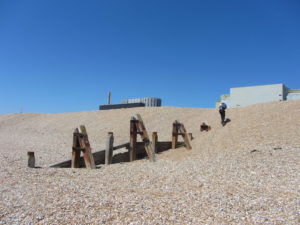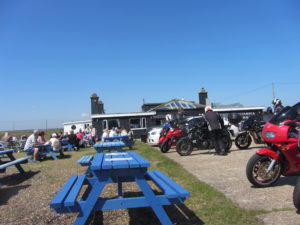I’ve already done one review on Dungeness but we visited again on Spring Bank Holiday so I have an update to include one short walk past the nuclear power station and another to see a memorial to two Polish airmen.
I was a bit reluctant to go to Dungeness on a hot day over the Bank Holiday as I doubted we’d be able to find a parking space and my love of Dungeness is mainly due to its bleakness and lack of crowds. However, my son was staying with us and he was keen to revisit so I relented – although I did pack some sandwiches as I thought we might find it difficult to get a table at one of the two pubs or in the railway cafe. We drove through the deserted Romney Marsh to New Romney and from there along the coastal road through Littlestone, Greatstone and Lydd-on Sea; there was quite a lot of traffic, but it wasn’t too bad. The car park off the coastal road at Lydd-on-Sea has public toilets and there were no parking spaces as they were all taken by kite surfers, the beaches before Dungeness being ideal for this sport. Also, when we reached the Dungeness Estate cars were parked on shingle at the sides of the road, where there are notices warning drivers not to park because of the soft verges. A camerman was filming people eating at the Snack Shack as we passed by. We were lucky and found a single vacant space in the small car park near The Britannia pub; there were also vacant spaces in the pub car park: I think we could probably have got something to eat at the pub as there were vacant outside picnic tables and a restricted menu – fish and chips, burgers, etc. – they were also doing a roaring trade in icecreams. “For more details about the Britannia Pub, Dungeness”:http://www.britanniadungeness.co.uk
We set off for a walk along the beach, away from everyone else, towards the power stations, one of which is still operating although it is due to be closed down in 2028. I find it difficult walking on the shingle and I made slow progress but the scene was idyllic – blue sky and lots of anglers sitting at the waters edge watching their fishing lines. There’s a huge `wall` of shingle in front of the power stations, obviously banked up to provide some protection from waves washing the pebbles away so at this point, having taken some photos of the towering power stations I struggled up the steep slope on all fours to join my menfolk. The slope on the other side was not so steep and we headed back along the power station perimeter roadway only to see a footpath sign pointing back the other way. Until then we hadn’t realised that there was a public footpath alongside the power stations and I haven’t seen it called part of the England Coast Path, but perhaps this section will be included soon. The path is on top of a narrow concrete wall with the power station fence on one side and large sea defence boulders piled on the other; not exactly the prettiest section of the coast walk. It was baking hot walking on the concrete and the only view was of the power stations. On reaching the end of the wall we climbed down some steps, across some shingle and continued along a concrete road for a while. Before us, marching across the marshes, was a line of giant pylons carrying the power from a huge building outside the power station. We walked along the remainder of the track until we could see the sea again on the other side of the boulders. Two walkers passed us, heading for Dungeness. It was lucky we hadn’t all met while on the narrow concrete wall as it wasn’t wide enough for social distancing. Ahead of us sun glinted on some cars parked near the beach at Jurys Gap and we guessed they belonged to more anglers: the beach round the Dungeness spit is not one for bathing as it’s far too dangerous. A family with children trudged by, well strung out, having walked all the way from Dungeness round the other side of the power station by the RSPB reserve, a little girl trailing at the back with her father was obviously not impressed with such a long walk so we were able to reassure her that she didn’t have much further to go. We turned around ourselves then as the coastal path goes inland around the Lydd (military) Ranges and we retraced our steps back to the Britannia for very welcome cold drinks. Then we headed past the Romney Hythe and Dymchurch Light Railway station and were pleased to see the trains were really busy, the Winston Churchill engine just leaving with 11 packed carriages. We left the crowds behind and walking again across shingle, followed the route of a disused railway track towards the bird reserve and rediscovered a memorial to two WW2 Polish airmen, one who was shot down in the sea nearby and the other whose plane crashed on the foreshore.
We took a different route home, this time along Stone Street, a Roman road from Lympne (then a port) to Canterbury, near the end of which sits our house with its view of the cathedral in the distance.















